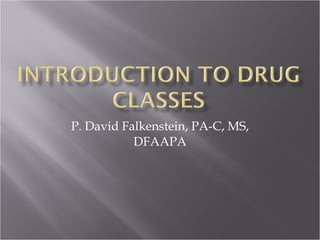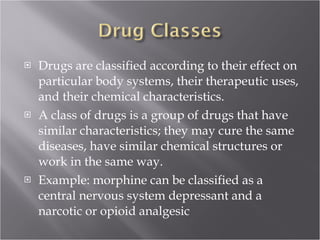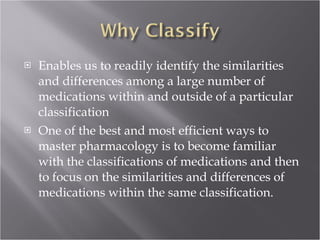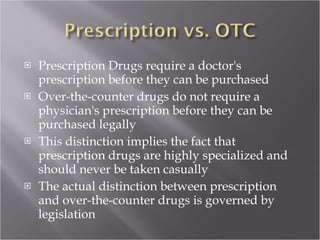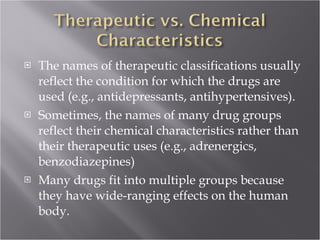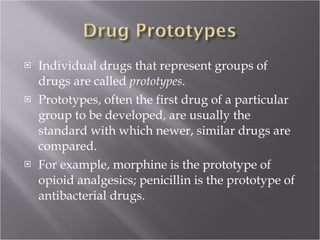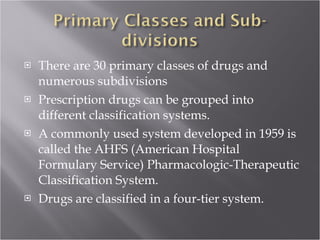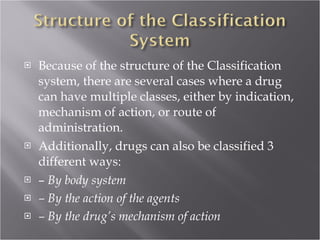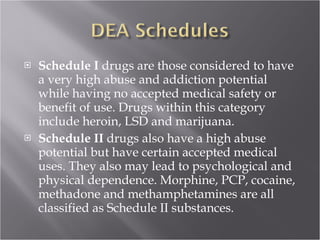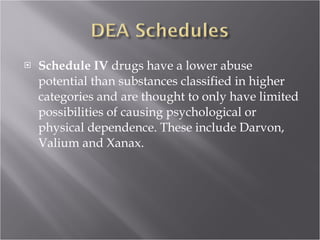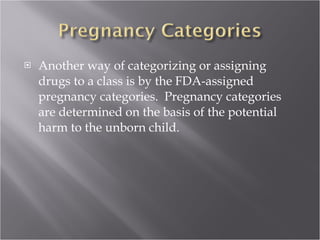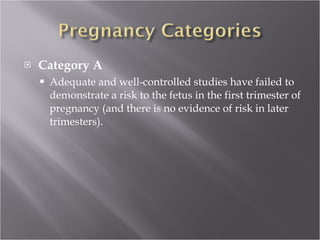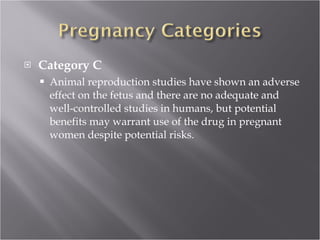Intro drugclasses
- 1. P. David Falkenstein, PA-C, MS, DFAAPA
- 2. Drugs are classified according to their effect on particular body systems, their therapeutic uses, and their chemical characteristics. A class of drugs is a group of drugs that have similar characteristics; they may cure the same diseases, have similar chemical structures or work in the same way. Example: morphine can be classified as a central nervous system depressant and a narcotic or opioid analgesic
- 3. Enables us to readily identify the similarities and differences among a large number of medications within and outside of a particular classification One of the best and most efficient ways to master pharmacology is to become familiar with the classifications of medications and then to focus on the similarities and differences of medications within the same classification.
- 4. Prescription Drugs require a doctor's prescription before they can be purchased Over-the-counter drugs do not require a physician's prescription before they can be purchased legally This distinction implies the fact that prescription drugs are highly specialized and should never be taken casually The actual distinction between prescription and over-the-counter drugs is governed by legislation
- 5. The names of therapeutic classifications usually reflect the condition for which the drugs are used (e.g., antidepressants, antihypertensives). Sometimes, the names of many drug groups reflect their chemical characteristics rather than their therapeutic uses (e.g., adrenergics, benzodiazepines) Many drugs fit into multiple groups because they have wide-ranging effects on the human body.
- 6. Individual drugs that represent groups of drugs are called prototypes . Prototypes, often the first drug of a particular group to be developed, are usually the standard with which newer, similar drugs are compared. For example, morphine is the prototype of opioid analgesics; penicillin is the prototype of antibacterial drugs.
- 7. There are 30 primary classes of drugs and numerous subdivisions Prescription drugs can be grouped into different classification systems. A commonly used system developed in 1959 is called the AHFS (American Hospital Formulary Service) Pharmacologic-Therapeutic Classification System. Drugs are classified in a four-tier system.
- 8. Because of the structure of the Classification system, there are several cases where a drug can have multiple classes, either by indication, mechanism of action, or route of administration. Additionally, drugs can also be classified 3 different ways:Ėý â By body system â By the action of the agents â By the drugâs mechanism of action
- 9. Drugs can also be identified or classified by one of three names : Chemical â long name, refers to the chemical structure of the drug Generic â shorter name derived from the chemical name Trade â brand name assigned by the manufacturer Drugs within the same class typically have similar sounding generic names (e.g., atenolol, metropolol, labetalol), all of which are in a drug class called beta-blockers.
- 10. Drugs are also placed into one of five drug classes, or schedules, by the DEA based on abuse according to their abuse potential, addictive nature and whether or not they have accepted medical use for treatment. A controlled substance is placed in its respective schedule based on whether it has a currently accepted medical use in treatment in the United States and its relative abuse potential and likelihood of causing dependence.
- 11. Schedule I drugs are those considered to have a very high abuse and addiction potential while having no accepted medical safety or benefit of use. Drugs within this category include heroin, LSD and marijuana. Schedule II drugs also have a high abuse potential but have certain accepted medical uses. They also may lead to psychological and physical dependence. Morphine, PCP, cocaine, methadone and methamphetamines are all classified as Schedule II substances.
- 12. Schedule III drugs are thought to have less abuse potential than those classified at I or II level drugs and have accepted treatment uses. These have a small to moderate chance of the development of physical or psychological dependence. Two well-known substances within this category include anabolic steroids and Tylenol with Codeine.
- 13. Schedule IV drugs have a lower abuse potential than substances classified in higher categories and are thought to only have limited possibilities of causing psychological or physical dependence. These include Darvon, Valium and Xanax.
- 14. Schedule V is the last category of federally scheduled substances. These are thought to have the lowest abuse potential of all scheduled drugs and have a very limited chance of dependence. They also have accepted medical uses. Over the counter cough medicines with codeine are placed within this category.
- 15. Another way of categorizing or assigning drugs to a class is by the FDA-assigned pregnancy categories. Pregnancy categories are determined on the basis of the potential harm to the unborn child.
- 16. Category A Adequate and well-controlled studies have failed to demonstrate a risk to the fetus in the first trimester of pregnancy (and there is no evidence of risk in later trimesters).
- 17. Category B Animal reproduction studies have failed to demonstrate a risk to the fetus and there are no adequate and well-controlled studies in pregnant women.
- 18. Category C Animal reproduction studies have shown an adverse effect on the fetus and there are no adequate and well-controlled studies in humans, but potential benefits may warrant use of the drug in pregnant women despite potential risks.
- 19. Category D There is positive evidence of human fetal risk based on adverse reaction data from investigational or marketing experience or studies in humans, but potential benefits may warrant use of the drug in pregnant women despite potential risks.
- 20. Ėý Category X Studies in animals or humans have demonstrated fetal abnormalities and/or there is positive evidence of human fetal risk based on adverse reaction data from investigational or marketing experience, and the risks involved in use of the drug in pregnant women clearly outweigh potential benefits

